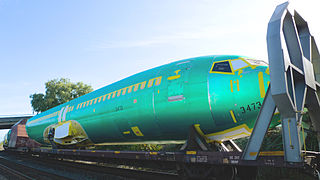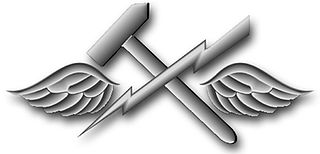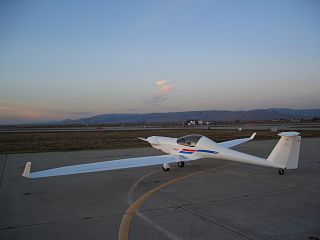| Aviation Structural Mechanic | |
|---|---|
 Rating insignia | |
| Issued by | United States Navy |
| Type | Enlisted rating |
| Abbreviation | AM |
| Specialty | Aviation |
Aviation structural mechanic (abbreviated as AM) is a United States Navy occupational rating.
| Aviation Structural Mechanic | |
|---|---|
 Rating insignia | |
| Issued by | United States Navy |
| Type | Enlisted rating |
| Abbreviation | AM |
| Specialty | Aviation |
Aviation structural mechanic (abbreviated as AM) is a United States Navy occupational rating.

Aviation Structural Mechanics maintain aircraft airframe and structural components including flight surfaces and controls, hydraulic and pneumatic control and actuating systems and mechanisms, landing gear systems, air conditioning, pressurization, visual improvement, oxygen and other utility systems, egress systems including seat and canopy ejection systems and components. They fabricate and repair metallic and nonmetallic materials; perform aircraft daily, special, hourly, and conditional inspections, supervise operation of airframe work centers; maintain aircraft metallic and non-metallic structures including fuselages, fixed and moveable flight surfaces, tail booms, doors, panels, decks, empennages, and seats (except ejection seats); flight controls and related mechanisms; hydraulic power storage and distribution systems including main (primary and secondary), auxiliary (utility), and emergency systems; hydraulic actuating subsystems; landing gear systems including wheels and tires, brakes, and emergency systems; pneumatic power, storage and distribution systems; hoists and winches, wing and tail fold systems; launch and arresting gear systems; hydraulic component repair and test. [1]
Aviation Structural Mechanics, Safety Equipment (AME) maintain safety belts, shoulder harnesses and integrated flight harnesses in aircraft, inertia reels, seat and canopy ejection systems, gaseous and liquid oxygen systems, life raft ejection systems, fire extinguishing systems excluding fire detection systems, portable fire extinguishers, emergency egress systems, air-conditioning, heating cabin and cockpit pressurization, ventilating and anti-G-systems, visual improvement systems, other utility systems and associated lines, fittings, rigging, valves and control mechanisms; replenish liquid and gaseous oxygen systems; remove and install oxygen system valves, gauges, converters and regulators; inspect, remove, install and rig ejection seats, shoulder harnesses, lap belts and face curtain mechanisms; inspect, remove, install and adjust firing mechanisms and cartridges for ejection seats, lap belts and canopies; operate and maintain liquid nitrogen and liquid and gaseous oxygen shop transfer and recharge equipment; perform daily, pre-flight, post-flight and other periodic aircraft inspections. [2]
Since 2001, the Occupational Rating has been divided into two Service Ratings for E3-E7:
At the E-8 level, AM and AME Personnel may be advanced to AMCS (Senior Chief Aviation Structural Mechanic). At the E-9 level, AMCS and ADCS (Senior Chief Aviation Machinist's Mate) Personnel look towards advancement to AFCM (Master Chief Aviation Maintenanceman).

Aviation Structural Mechanics may be assigned to sea or Shore Duty in any place in the world, so their working environment varies considerably. They may work in hangars or hangar decks, or outside on flight decks or flight lines at Air Stations. A high noise level is a normal part of their work environment. AMs work closely with others, do mostly physical work and require little supervision. AMs may also serve as flight engineers aboard certain aircraft. [3]
ASVAB score requirement: VE+AR+MK+AS = 210 OR VE+AR+MK+MC = 210
Security clearance requirement: None (except for those who volunteer for aircrew duty)
Other requirements: [3]
Between 1948 and 2001, the AM Rating consisted of two additional Service Ratings:
AMEs maintain and repair oxygen, cockpit and cabin pressurization, and ejection seat systems. The AMH was for hydraulic systems (landing gear, brakes, flight controls and all related). The AMS was structural/sheet metal. Today's AM Rating began from the aviation metalsmith used between 1921 and 1948. In 2001, the AMS and AMH Ratings were merged to form the AM Rating, the AME Rating remains a separate and distinct rating.

In aircraft, an ejection seat or ejector seat is a system designed to rescue the pilot or other crew of an aircraft in an emergency. In most designs, the seat is propelled out of the aircraft by an explosive charge or rocket motor, carrying the pilot with it. The concept of an ejectable escape crew capsule has also been tried. Once clear of the aircraft, the ejection seat deploys a parachute. Ejection seats are common on certain types of military aircraft.

The Vought F7U Cutlass is a United States Navy carrier-based jet fighter and fighter-bomber designed and produced by the aircraft manufacturer Chance Vought. It was the first tailless production fighter in the United States as well as United States Navy's first jet equipped with swept wings and the first to be designed with afterburners.
The Enlisted Aviation Warfare Specialist (EAWS) insignia is a military badge of the United States Navy which was created in March 1980. The insignia recognizes those members of the Navy's enlisted force who have acquired the specific professional skills, knowledge, and military experience that result in qualification for service in the aviation activities of the Navy. This includes most personnel who are trained flight deck personnel onboard aircraft carriers, or maintenance personnel at an Aircraft Intermediate Maintenance Detachment or Department (AIMD) or aircraft squadron.

An oxygen mask provides a method to transfer breathing oxygen gas from a storage tank to the lungs. Oxygen masks may cover only the nose and mouth or the entire face. They may be made of plastic, silicone, or rubber. In certain circumstances, oxygen may be delivered via a nasal cannula instead of a mask.

Cabin pressurization is a process in which conditioned air is pumped into the cabin of an aircraft or spacecraft in order to create a safe and comfortable environment for humans flying at high altitudes. For aircraft, this air is usually bled off from the gas turbine engines at the compressor stage, and for spacecraft, it is carried in high-pressure, often cryogenic, tanks. The air is cooled, humidified, and mixed with recirculated air by one or more environmental control systems before it is distributed to the cabin.

The Learjet 25 is an American ten-seat, twin-engine, high-speed business jet aircraft manufactured by Learjet. It is a stretched version of the Learjet 24.
A parachute rigger is a person who is trained or licensed to pack, maintain or repair parachutes. A rigger is required to understand fabrics, hardware, webbing, regulations, sewing, packing, and other aspects related to the building, packing, repair, and maintenance of parachutes.

In aeronautics, a variable-pitch propeller is a type of propeller (airscrew) with blades that can be rotated around their long axis to change the blade pitch. A controllable-pitch propeller is one where the pitch is controlled manually by the pilot. Alternatively, a constant-speed propeller is one where the pilot sets the desired engine speed (RPM), and the blade pitch is controlled automatically without the pilot's intervention so that the rotational speed remains constant. The device which controls the propeller pitch and thus speed is called a propeller governor or constant speed unit.

An aircraft canopy is the transparent enclosure over the cockpit of some types of aircraft. An aircraft canopy provides a controlled and sometimes pressurized environment for the aircraft's occupants, and allows for a greater field of view over a traditional flight deck. A canopy's shape is a compromise designed to minimize aerodynamic drag, while maximizing visibility for pilots and other crewmembers.

Stanley Aviation is an aerospace company started by Robert M Stanley, the aviation pioneer, in Buffalo, New York in 1948. The company has since acquired several other companies and has been most recently acquired by Eaton Corporation.

Aviation Electrician's Mate is a United States Navy occupational rating.

Aviation Support Equipment Technician is a United States Navy occupational rating. The United States Marine Corps currently maintains 3 separate aviation support equipment military occupational specialties. They are: 6071, 6072 aircraft maintenance support equipment hydraulic/ pneumatic structures mechanic and 6073 aircraft maintenance support equipment electrician / refrigeration mechanic.

Aircraft emergency oxygen systems or air masks are emergency equipment fitted to pressurized commercial aircraft, intended for use when the cabin pressurisation system has failed and the cabin altitude has climbed above a safe level. It consists of a number of individual yellow oxygen masks stored in compartments near passenger seats and near areas like lavatories and galleys, and an oxygen source, like a centralized gaseous cylinder or decentralized chemical oxygen generator.

Jat Tehnika is a Serbian aerospace company providing aircraft maintenance, repair and overhaul. The company is based at Belgrade Nikola Tesla Airport and provides services for Air Serbia and other airlines across Europe.

The AMS-Flight Carat A is a single-seat, high performance motorglider. The sailplane was originally designed and built by Technoflug in Germany and is now manufactured by AMS-Flight in Slovenia.

Nigeria Airways Flight 2120 was a chartered passenger flight from Jeddah, Saudi Arabia, to Sokoto, Nigeria, on 11 July 1991, which caught fire shortly after takeoff from King Abdulaziz International Airport and crashed while attempting to return for an emergency landing, killing all 247 passengers and 14 crew members on board. The aircraft was a Douglas DC-8 operated by Nationair Canada for Nigeria Airways. Flight 2120 is the deadliest accident involving a DC-8 and remains the deadliest aviation disaster involving a Canadian airline.

The Martin-Baker Mk.5 is a British ejection seat designed and built by Martin-Baker. Introduced in the late 1950s, the Mk.5 has been installed in combat and training aircraft worldwide.

The Martin-Baker Mk.4 is a British ejection seat designed and built by Martin-Baker. Introduced in the 1950s, the Mk.4 has been installed in combat and training aircraft worldwide.

Aircrew survival equipmentmen are survival equipment specialists and certified parachute riggers who oversee valuable life saving equipment, parachutes, and other special gear used by U.S. Naval and Marine Corps special operations forces, Naval Air Department, and the United States Navy Parachute Team known as the "Leap Frogs". They perform a wide range of duties, which include inspecting, maintaining, and repairing parachutes, search and rescue equipment, along with survival kits, medical kits, flight clothing, protective wear, night vision equipment, aircrew oxygen systems, liquid oxygen converters, anti-exposure suits, and g-suits. PRs operate and maintain carbon dioxide transfer and recharge equipment, operate and repair sewing machines as well as train aircrew and other personnel in parachute rigging and the use of safety and survival equipment.
![]() Media related to Aviation Structural Mechanic at Wikimedia Commons
Media related to Aviation Structural Mechanic at Wikimedia Commons